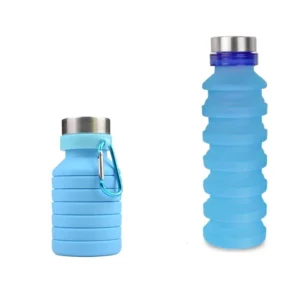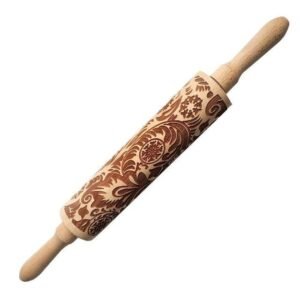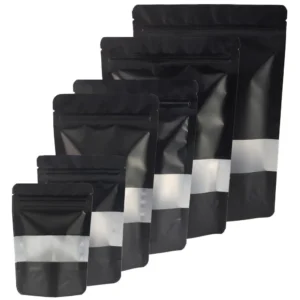- Introduction
- Understanding Belgian Waffles
- Ingredients for the Perfect Belgian Waffle
- Step-by-Step Belgian Waffle Recipe
- Belgian Waffles vs Regular Waffles: The Differences
- Equipment for Making Belgian Waffles
- Serving and Pairing Belgian Waffles
- Tips and Tricks for Crispy Waffles
- Storing and Reheating Belgian Waffles
- FAQs on Belgian Waffle Preparation
- Conclusion
- FAQs
- Frequently Linked Pages
Introduction
Belgian waffles are not just a breakfast favorite, but also a cultural icon? These light and fluffy delights have become a beloved treat worldwide. If you’ve ever wondered how to recreate the scrumptiousness of Belgian waffles in your own kitchen, look no further. We’ve got the inside scoop on the secrets to making perfect Belgian waffles at home.
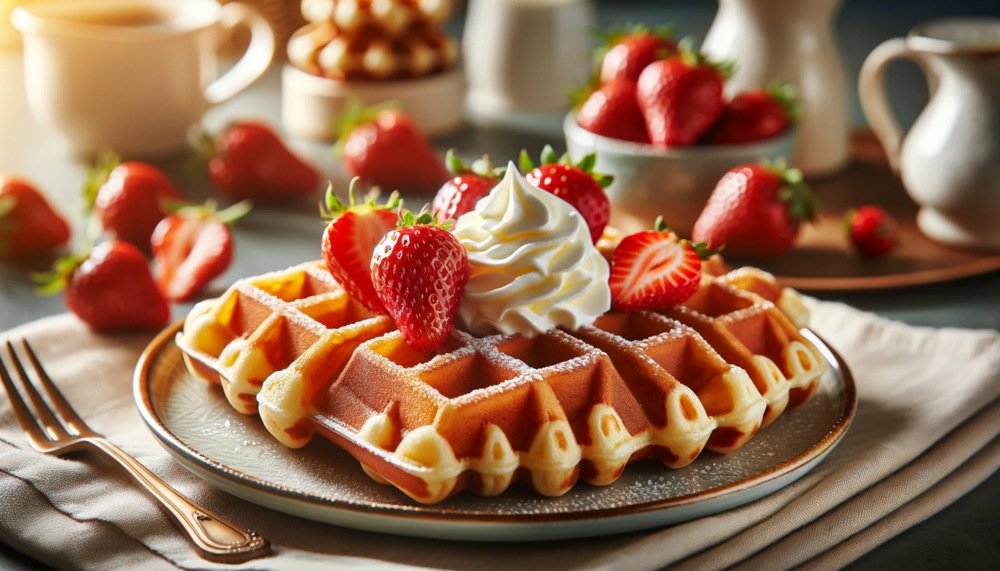
In this Blogpost, we’ll share foolproof instructions and directions for achieving that signature crispy exterior and tender interior. From choosing the right ingredients to mastering the cooking process, we’ve got you covered. Whether you prefer them topped with butter and maple syrup or loaded with fresh fruit and whipped cream, our recipes will satisfy your cravings.
So get ready to embark on a mouthwatering journey as we reveal the best way to enjoy homemade Belgian waffles with your family. Stay tuned for delicious recipes that will have everyone coming back for seconds!
Understanding Belgian Waffles
Belgian waffles are more than just a breakfast staple; they have a rich history and cultural significance. These delectable treats originated in Belgium, a country known for its culinary delights. Let’s delve into the world of Belgian waffles and explore what makes them unique.
History and Cultural Significance
Belgian waffles have been enjoyed by people for centuries. They first gained popularity during the Middle Ages when bakers started using leavening agents like yeast to create light and fluffy waffles. The word “waffle” itself is derived from the Dutch word “wafel,” which means honeycomb or grid pattern.
In Belgium, waffles are deeply ingrained in the culture and traditions of the country. They are often associated with celebrations, such as religious festivals and street fairs. In fact, you can find numerous street vendors selling freshly baked Belgian waffles topped with powdered sugar, fruit, or even chocolate sauce.
Key Characteristics of Belgian Waffles
So, what sets Belgian waffles apart from other types? One distinctive feature is their light and airy texture. Unlike traditional American-style waffles that tend to be denser, Belgian waffles have a crisp exterior while remaining soft on the inside. This contrast in textures creates an incredibly satisfying bite.
Another characteristic that distinguishes Belgian waffles is their deep pockets. These deep indentations serve as perfect little reservoirs for holding syrup, butter, or any other delicious toppings you desire. The larger surface area also allows for more even cooking and ensures that every bite is filled with flavor.
Exploring Variations of Belgian Waffle Recipes
Belgian waffle recipes offer endless possibilities for customization and creativity in the kitchen. While the classic version typically consists of flour, eggs, milk, sugar, and butter, there are various variations to suit different tastes.
One popular variation is Liege-style Belgian waffles, which are made with a dough-like batter enriched with chunks of pearl sugar. When cooked, the sugar caramelizes and creates a delightful crunch. These waffles are often enjoyed on their own or with a sprinkle of powdered sugar.
Another beloved variation is Brussels-style Belgian waffles. These waffles have a lighter texture and are typically rectangular in shape. They are perfect for pairing with whipped cream, fresh fruits, or even savory toppings like ham and cheese.
Ingredients for the Perfect Belgian Waffle
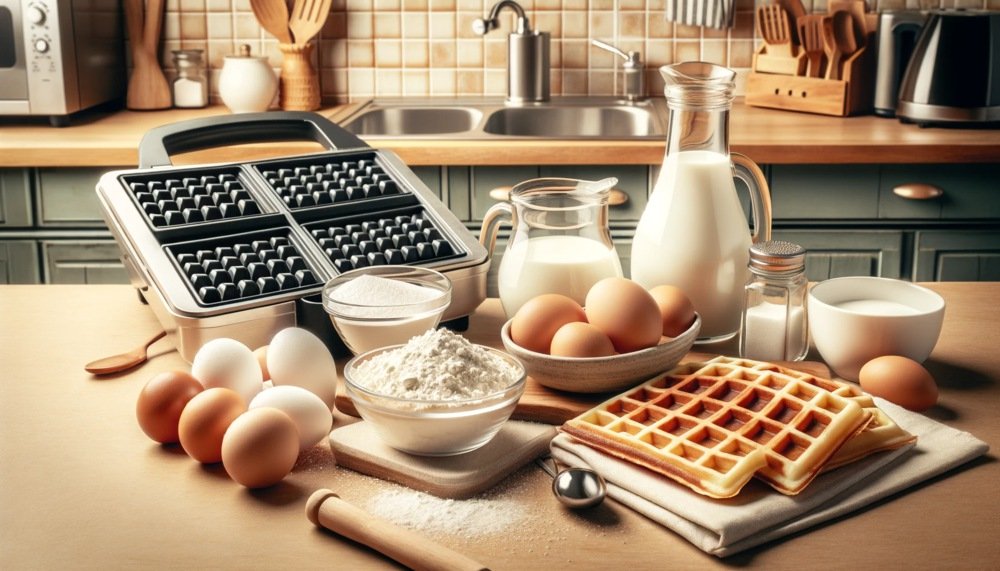
Essential ingredients for a delicious Belgian waffle
To create the perfect Belgian waffle, you need to have the right ingredients on hand. Each ingredient plays a crucial role in achieving that mouthwatering taste and fluffy texture we all crave. Let’s take a closer look at these essential components.
Wet ingredients: eggs and milk
Eggs are a key player in creating that light and airy texture of Belgian waffles. They provide structure and help bind the other ingredients together. When whisked properly, they add volume to the batter, resulting in a fluffy end product. Milk adds moisture to the batter, making it tender and ensuring a delightful melt-in-your-mouth experience.
Dry ingredients: flour and leavening agent
Flour is the backbone of any waffle recipe, including Belgian waffles. It provides structure and stability to the batter while contributing to its flavor. All-purpose flour is commonly used, but you can experiment with different types like whole wheat or buckwheat for added depth. The leavening agent, usually baking powder, gives the waffles their signature rise by releasing carbon dioxide when heated.
The magic of egg yolks and egg whites
Belgian waffle recipes often call for both egg yolks and egg whites separately. Egg yolks add richness to the batter with their fat content, resulting in a more decadent flavor profile. On the other hand, egg whites are beaten until stiff peaks form before being gently folded into the batter. This step introduces air pockets that contribute to an incredibly light and fluffy texture.
Sweetening things up: sugar and maple syrup
Sugar not only adds sweetness but also aids in browning during cooking, giving your Belgian waffles that desirable golden color. Maple syrup can be used as both an ingredient within the batter or as a topping after cooking—either way, it adds a delightful touch of sweetness and enhances the overall flavor.
Whisking it all together
To ensure a smooth batter, whisking is essential. It helps incorporate air into the mixture, resulting in lighter waffles. Whisking also helps evenly distribute the ingredients and ensures that there are no lumps or pockets of dry flour remaining.
Optional toppings: powdered sugar and more
Once your Belgian waffles are cooked to perfection, you can take them to the next level with various toppings. A dusting of powdered sugar adds a touch of elegance and sweetness.
Step-by-Step Belgian Waffle Recipe
If you’re craving a delicious and fluffy breakfast treat, look no further than homemade Belgian waffles. With our easy-to-follow recipe guide, you’ll be able to whip up mouthwatering waffles from scratch in no time. Get ready to impress your family and friends with your culinary skills!
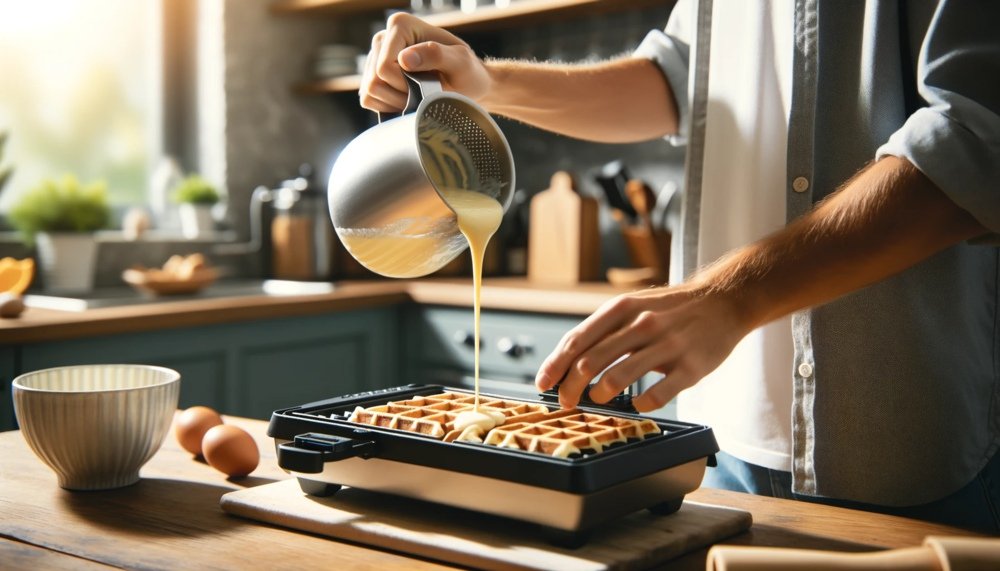
Mixing the Batter
To start off, gather all the ingredients listed in our previous section on “Ingredients for the Perfect Belgian Waffle.” Once you have everything ready, it’s time to mix the batter. In a large mixing bowl, combine the flour, sugar, baking powder, and salt. Give it a good whisk to ensure all the dry ingredients are well incorporated.
Next, create a well in the center of the dry mixture and add in the milk, melted butter, vanilla extract, and eggs. Use a whisk or an electric mixer on low speed to blend everything together until you achieve a smooth batter. Be careful not to overmix; we want our waffles light and airy!
Resting the Batter
Now that your batter is mixed to perfection, it’s important to let it rest for about 10-15 minutes before cooking. This resting period allows the gluten in the flour to relax and results in lighter waffles with better texture.
While your batter is resting, preheat your Belgian waffle iron according to its manufacturer’s instructions. Make sure it’s nice and hot before pouring in your batter.
Cooking Your Waffles
Once your batter has had its beauty sleep and your waffle iron is hot enough, it’s time to cook those delectable waffles! Carefully pour an appropriate amount of batter onto each section of your preheated waffle iron—just enough to cover the surface without overflowing.
Close the lid gently but firmly and let magic happen! Cook for about 3-4 minutes or until golden brown. The exact cooking time may vary depending on your waffle iron, so keep an eye on them to avoid burning.
Achieving the Perfect Texture
The key to achieving that perfect balance of crispy exteriors and tender interiors lies in a few simple tricks. Firstly, make sure not to stack your cooked waffles on top of each other as they will lose their crispiness. Instead, place them in a single layer on a wire rack to cool slightly.
Belgian Waffles vs Regular Waffles: The Differences
Belgian waffles and regular waffles may seem similar at first glance, but there are some key distinctions between the two. Let’s dive into the differences and discover which type of waffle suits your taste buds best.
Batter Consistency: Light and Fluffy or Dense and Chewy
Belgian waffles take the cake. These waffles are known for their light and fluffy texture, achieved by using yeast in the batter. On the other hand, regular waffles have a denser and chewier texture due to the use of baking powder or baking soda as leavening agents. So, if you prefer a lighter bite that melts in your mouth, go for Belgian waffles.
Shape and Size: Square Pockets or Round Grids
Belgian waffles are famous for their deep square pockets that hold all those delicious toppings like syrup, fruits, or whipped cream. These pockets create a perfect balance of crispy edges and soft centers. In contrast, regular waffles typically have round grids with shallow pockets, offering a more even distribution of toppings across each bite. So, if you’re all about those syrup-filled squares, Belgian waffles are the way to go.
Flavor Profile: Sweet Vanilla or Buttermilk Goodness
Authentic Belgian waffles boast a delicate vanilla flavor with hints of sweetness throughout. They often rely on pearl sugar for that extra crunch and caramelization when cooked. Regular waffles tend to have a subtle buttermilk flavor that pairs well with both sweet and savory toppings alike. So whether you crave a hint of vanilla or enjoy the tanginess of buttermilk, choose your flavor profile wisely.
Toppings Galore: Versatility is Key
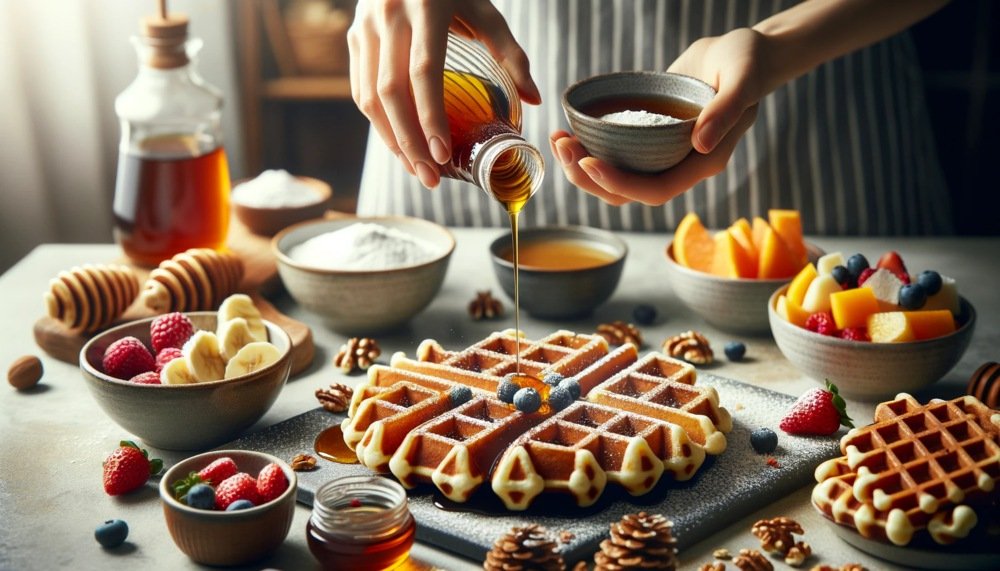
Both types of waffles offer endless possibilities. However, due to their deep pockets, Belgian waffles are better suited for holding a variety of toppings and sauces. From fresh berries and whipped cream to Nutella and ice cream, the sky’s the limit with these versatile waffles. Regular waffles, with their flatter grids, can also hold a range of toppings but may not be as accommodating as their Belgian counterparts.
Equipment for Making Belgian Waffles
To make authentic Belgian waffles at home, you’ll need the right equipment. Here are some essential kitchen tools that will help you create delicious Belgian waffles.
Waffle Maker or Iron
The most crucial piece of equipment for making Belgian waffles is a waffle maker or iron. These appliances come in various shapes and sizes, so it’s important to choose one that suits your needs. Look for a waffle maker with deep grids to achieve the characteristic crispy exterior and light, fluffy interior of Belgian waffles.
When selecting a waffle maker, consider factors like cooking time, temperature control options, and ease of use. Some models offer adjustable temperature settings, allowing you to customize the browning level of your waffles. Others may have indicator lights or audible alerts to let you know when the waffles are ready.
Recommendations
If you’re looking for a reliable and versatile option, the Cuisinart WAF-F20 Double Belgian Waffle Maker is worth considering. It features two non-stick plates that can be rotated independently, allowing you to cook two large Belgian-style waffles simultaneously.
For those who prefer a more compact option or have limited counter space, the Dash Mini Waffle Maker is an excellent choice. Despite its small size, this little machine can produce perfectly sized mini Belgian waffles in just minutes.
Maintaining and Cleaning Your Equipment
To ensure optimal performance from your waffle maker or iron, proper maintenance and cleaning are essential. Always refer to the manufacturer’s instructions for specific care guidelines. However, here are some general tips:
1. Allow your equipment to cool down before cleaning.
2. Use a soft cloth or sponge to wipe away any excess batter or crumbs.
3. For stubborn residue, gently scrub with a non-abrasive brush.
4. Avoid using harsh chemicals or abrasive cleaners that could damage the non-stick coating.
5. If your waffle maker has removable plates, check if they are dishwasher safe for easy cleaning.
6. Regularly cleaning and maintaining your waffle maker will not only prolong its lifespan but also ensure that each batch of waffles turns out perfect.
Serving and Pairing Belgian Waffles

Creative Serving Suggestions for Freshly Made Belgian Waffles
Now that you’ve mastered the art of making delicious Belgian waffles, it’s time to explore creative ways to serve and elevate your enjoyment of these delectable treats. While classic toppings like whipped cream, berries, or chocolate sauce are always a hit, there are countless other options to consider.
One idea is to create a DIY waffle bar where everyone can customize their own creations. Set out an array of toppings such as fresh fruit slices, nuts, sprinkles, honey, maple syrup, or even Nutella. This interactive experience allows each person to tailor their waffle just the way they like it.
Another fun serving suggestion is to transform your Belgian waffles into ice cream sandwiches. Simply slice the waffle in half horizontally and sandwich a scoop of your favorite ice cream flavor in between. The warm and crispy exterior paired with the cold and creamy ice cream creates a delightful contrast that will have your taste buds singing.
For those who enjoy a touch of elegance, try serving your Belgian waffles with a dollop of flavored whipped cream and a dusting of powdered sugar. You can also add a drizzle of caramel or raspberry sauce for an extra burst of flavor. This combination is perfect for special occasions or when you want to impress your guests with something fancy.
Classic Toppings That Never Fail
While experimenting with new flavors is exciting, sometimes sticking to classic toppings is just what you need for that nostalgic taste. Whipped cream remains an all-time favorite topping for many people. Its light and fluffy texture complements the crispiness of the waffle perfectly.
Fresh berries are another timeless choice that adds a burst of freshness and natural sweetness to every bite. Whether it’s strawberries, blueberries, raspberries, or a combination thereof – they are sure to bring vibrancy and color to your plate.
And of course, who can resist the allure of a rich and velvety chocolate sauce cascading over your waffle? Whether you opt for milk, dark, or white chocolate – it’s a surefire way to satisfy any chocolate lover’s cravings.
Tips and Tricks for Crispy Waffles
Achieving That Coveted Crispy Exterior
To make your Belgian waffles perfectly crispy on the outside, there are a few expert tips you should keep in mind. First and foremost, ensure that your batter is mixed just right. It should be smooth and well-combined, but be careful not to overmix it. Overmixing can lead to tough waffles instead of light and crispy ones.
Another key factor in achieving crispiness is the use of stiff peaks when beating your egg whites. When whisking the egg whites, continue until they reach a point where they hold their shape firmly when the whisk is lifted. These stiff peaks form will give your waffles an airy texture while contributing to that delicious crunch.
Preventing Soggy Waffles
Nobody wants a soggy waffle, so here’s how you can prevent it. One effective method is to preheat your waffle iron properly before pouring in the batter. This ensures that the heat is evenly distributed from the start, allowing for even cooking and browning.
Avoid stacking cooked waffles on top of each other as they come out of the iron. The steam released by hot waffles can cause them to lose their crispness quickly. Instead, lay them out on a wire rack or place them directly on an oven rack to maintain their crunchiness.
Adjusting Cooking Times and Temperatures
Cooking times and temperatures play a crucial role in achieving the desired level of crispiness for your Belgian waffles. If you prefer a lighter golden color with a softer interior, opt for lower heat settings and shorter cooking times.
On the other hand, if you’re all about that deep golden brown with an extra crispy texture, crank up the heat slightly and allow for longer cooking times. Remember though—don’t go overboard! You want your waffles to be crispy, not burnt.
Experimenting with different heat settings and cooking times will help you find your sweet spot. Keep in mind that each waffle iron may have its own quirks, so don’t be afraid to adjust accordingly.
With these tips and tricks up your sleeve, you’re well on your way to creating irresistibly crispy Belgian waffles. Remember to mix your batter just right, beat those egg whites until stiff peaks form, preheat your waffle iron properly, and adjust cooking times and temperatures based on personal preferences.
Storing and Reheating Belgian Waffles
Properly storing leftover Belgian waffles
If you find yourself with some leftover Belgian waffles, don’t let them go to waste! With the right storage techniques, you can enjoy these delectable treats for days to come. To store your leftover waffles, begin by allowing them to cool completely at room temperature. Placing warm waffles in a container can trap moisture and make them soggy.
Once your waffles have cooled down, you have a few options for storage. If you plan on enjoying them within a day or two, simply place them in an airtight container or wrap them tightly in plastic wrap. This will help prevent any air from reaching the waffles and keep them fresh.
If you want to save your waffles for longer periods, consider freezing them. Freezing is an excellent way to preserve their taste and texture. Start by arranging your homemade Belgian waffles on a baking sheet in a single layer and place the sheet in the freezer until they are frozen solid. Once frozen, transfer the waffles to a freezer-safe bag or container. Be sure to label it with the date so that you can keep track of how long they’ve been stored.
Reheating methods for maintaining texture
When it’s time to enjoy your stored Belgian waffles, reheating is key to bringing back their delightful crispiness. While microwaving may be convenient, it often results in soggy waffles. Instead, opt for other methods that will help retain their texture.
One popular method is using a toaster or toaster oven. Simply preheat your toaster or toaster oven and place the frozen or room temperature waffle directly into the slots or onto the rack. Toast until heated through and crispy on the outside.
Another option is using an oven. Preheat your oven to around 350°F (175°C) and place your frozen or room temperature waffles on a baking sheet. Bake for about 5-7 minutes or until they are heated through and crispy.
Creative ways to repurpose leftover waffles
If you’re looking to get creative with your leftover Belgian waffles, there are plenty of delicious possibilities. One idea is to turn them into a decadent dessert by topping them with ice cream, whipped cream, and your favorite toppings like chocolate sauce or fresh berries.
FAQs on Belgian Waffle Preparation
Ingredient Substitutions and Dietary Restrictions
Have you ever found yourself in the middle of a recipe, only to realize that you’re missing a key ingredient? Don’t worry, we’ve got you covered. If you don’t have buttermilk on hand, simply mix together some milk with a tablespoon of lemon juice or vinegar as a substitute. And for those with dietary restrictions, fear not! You can easily make your waffles gluten-free by swapping out regular flour for a gluten-free alternative like almond flour or a gluten-free baking blend.
Troubleshooting Tips for Common Issues
Sometimes things don’t go as planned in the kitchen, but that doesn’t mean you should give up on your quest for perfect Belgian waffles. One common issue is getting the batter consistency just right. If your batter seems too thick, add a splash of milk to thin it out. On the other hand, if it’s too runny, sprinkle in some extra flour until it reaches the desired thickness. Another problem many face is waffles sticking to the iron. To prevent this sticky situation, make sure to generously grease the waffle iron before pouring in the batter.
Alternative Cooking Methods
Not everyone has access to a traditional waffle maker at home, but that shouldn’t stop you from enjoying delicious Belgian waffles. If you find yourself without one, there are still alternative cooking methods available. One option is using a stovetop griddle or frying pan instead of an electric waffle iron. Simply pour the batter onto the heated surface and cook until golden brown on both sides. Another creative solution is using an oven-safe dish or muffin tin to bake individual portions of waffle batter in the oven. This method may not create traditional-shaped waffles but will still deliver that crispy exterior and fluffy interior we all love.
It’s important to have some tricks up your sleeve. Whether you need ingredient substitutions, troubleshooting tips, or alternative cooking methods, we hope these FAQs have answered your burning questions. So go ahead and get creative in the kitchen—break out that waffle iron or try one of the alternative methods mentioned above—and treat yourself to a stack of mouthwatering Belgian waffles.
Conclusion
Armed with the knowledge of the perfect ingredients, step-by-step recipe, and tips for achieving crispy perfection, you’re ready to impress your friends and family with your culinary skills. But it doesn’t stop there. Take your Belgian waffle game to the next level by experimenting with different toppings and flavor combinations. Whether you prefer classic maple syrup and butter or adventurous options like fresh fruit and whipped cream, the possibilities are endless. So go ahead, fire up that waffle iron, and let your creativity run wild. Your taste buds will thank you!
But don’t keep all this deliciousness to yourself! Share the joy of Belgian waffles with others. Host a brunch party or surprise your loved ones with a homemade breakfast in bed. Spread the love by sharing your newfound knowledge and passion for these delectable treats. And remember, practice makes perfect, so keep refining your skills and exploring new variations. Before you know it, you’ll be known as the Belgian waffle connoisseur among your friends and family. Enjoy every crispy bite!
FAQs
How do I make Belgian waffles at home?
Belgian waffles can be made at home by following a simple recipe. Start by whisking together flour, sugar, baking powder, and salt in a bowl. In a separate bowl, beat eggs and add melted butter and milk. Combine the wet and dry ingredients until just mixed. Preheat a waffle iron, pour the batter onto it, and cook until golden brown.
Can I substitute all-purpose flour with another type of flour?
Yes, you can substitute all-purpose flour with other types of flour to suit your dietary needs or preferences. For example, you can use whole wheat flour for added fiber or gluten-free flour for those with gluten sensitivities. Just keep in mind that different flours may alter the texture and taste of the waffles slightly.
What toppings go well with Belgian waffles?
Belgian waffles are versatile. Classic options include fresh berries, whipped cream, maple syrup, or powdered sugar. You can also get creative with savory toppings like fried chicken or bacon for a sweet-savory combination. Ultimately, choose toppings that complement your personal taste preferences.
Can I freeze leftover Belgian waffles?
Absolutely! If you have leftover Belgian waffles, let them cool completely before placing them in an airtight container or freezer bag. To prevent them from sticking together, separate each waffle layer with parchment paper or plastic wrap. When ready to enjoy again, simply reheat them in a toaster or oven until warm.
Are Belgian waffles healthier than regular waffles?
Belgian waffles are typically denser and thicker than regular waffles due to their yeast-based batter. While they may be more indulgent in terms of texture and flavor, their nutritional value largely depends on the ingredients used and portion size consumed. Opting for whole grain flours and lighter toppings can make them a healthier choice.
Frequently Linked Pages
1. Waffle and chicken – Waffle And Chicken: A Perfect Pairing For Delectable Delights
2. Belgian waffles near me – Belgian Waffles Near Me: Indulge In Irresistible Delights Nearby
3. Belgian waffles mix – Belgian Waffles Mix: Perfecting Breakfast Delights With Authentic Flavors
4. Belgian waffles calories – Belgian Waffle Calories: Nutrition Facts & Analysis
5. Waffle and mochi – Waffle And Mochi: A Delectable Duo Of Delights
6. Waffle and chicken near me – Waffle And Chicken Near Me: A Delicious Duo Just Around The Corner


